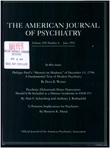Correction
Abstract
In the article "Sertraline in Obsessive-Compulsive Disorder: A Double-Blind Comparison With Placebo," by Michael A. Jenike, M.D., et al. (July 1990 issue, pp. 923-928), there are a number of errors that resulted from incorrect computer entry of the randomization code.
The final conclusions of the study are not changed, but a stronger trend toward usefulness of the drug is exhibited. In view of positive data from the multicenter trial of sertraline of which this was one center (G. Chouinard, W. Goodman, J. Greist, et al.: Results of a double-blind placebo controlled trial using a new serotonin uptake inhibitor, sertraline, in obsessive-compulsive disorder. Psychopharmacol Bull [in press]), it is likely that the nonsignificant differences from placebo are due to small sample size.
Patients in the placebo and sertraline groups were still similar in clinical characteristics (table 1 in the original paper), and there were few side effects in either group (table 2). The corrected table 3 below summarizes the corrected data analyses, which were done by means of analysis of covariance. All comparisons were nonsignificant beyond p> 0.10. On the Yale-Brown scale, the Maudsley questionnaire, and the global scale, the interaction effect was nonsignificant, so main effects can be unambiguously interpreted. On the NIMH scale, the interaction effect was significant, so main effects could not be unambiguously interpreted; thus, tests of simple main effects were carried out between drug and placebo at each of the five trials. None of the resuls of the tests of simple main effects was significant (all p> O.lO).
Also, to clarify a point in the paper, the new drug application requesting that obsessive-compulsive disorder be included as an indication for sertraline will not be submitted for some time, but an application was filed for depression as an indication in 1988 (personal communication, Pfizer Pharmaceutical Company).
[See table in the PDF file]
Access content
To read the fulltext, please use one of the options below to sign in or purchase access.- Personal login
- Institutional Login
- Sign in via OpenAthens
- Register for access
-
Please login/register if you wish to pair your device and check access availability.
Not a subscriber?
PsychiatryOnline subscription options offer access to the DSM-5 library, books, journals, CME, and patient resources. This all-in-one virtual library provides psychiatrists and mental health professionals with key resources for diagnosis, treatment, research, and professional development.
Need more help? PsychiatryOnline Customer Service may be reached by emailing [email protected] or by calling 800-368-5777 (in the U.S.) or 703-907-7322 (outside the U.S.).



